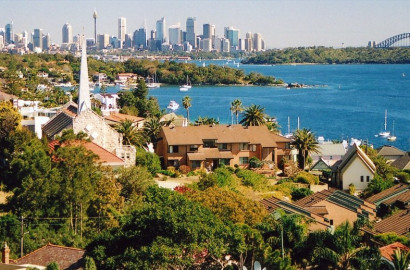
What’s the right strategy for this stage of the property cycle? When it comes to property investment, you’ll often hear two conflicting philosophies - invest for capital growth or invest for positive cash flow.
We're now at the beginning of a new property cycle, but it's likely we'll be facing relatively high interest rates for a while, and it may take another couple of years for inflation to settle into the 2-3% range the RBA prefers. This has prompted some investors to wonder if they should focus on cash flow positive properties.
You know... properties where the rental income covers all of the property’s expenses (including interest), leaving money in their pocket each month.
Which strategy is better? There’s no simple answer.
Clearly, both strategies have their place.
I see many novice investors leaning toward cash flow positive properties.
Most of the new so-called "property experts" advocate for cash flow investing - but following the majority can lead to average results - with 50% of investors selling up in the first 5 years and 92% never acquiring more than one or two properties.
Conversely, the successful investors I've assisted over the years, who have built substantial portfolios, have done so by capitalizing on the capital growth of their investments.
Note: I understand why many new investors are drawn to positive cash flow properties.
They tend to be more affordable, making it easier to enter the market and sustain such investments.
While these properties may offer immediate income, they don’t typically build the equity needed to achieve significant wealth.
Investors focused on cash flow are often concerned with immediate gains rather than long-term growth, purchasing properties that address short-term needs but fail to deliver substantial long-term outcomes.
They risk never amassing a large enough asset base to create a significant "Cash Machine."
I recognize that investors seek cash flow for financial freedom, but it’s essential to first build a substantial asset base, which can then be leveraged to generate cash flow - and it must be done in the right sequence.
You build a large asset base and then reduce your loan-to-value ratios, perhaps by investing in commercial properties or dividend-generating stocks.
Even though initial rents on cash flow properties can seem attractive, it’s the sustained capital growth that will bolster long-term rental income. Buying in areas with limited capital appreciation will likely result in modest rent increases over time.
Your future income depends on tenants’ ability to afford rising rents, which is why the demographics of the area where you invest are crucial - aim for locations with tenants who are financially stable.
Sure, cash flow is important, but minor weekly positive cash flow won’t significantly impact your lifestyle, whereas the absence of capital growth will hinder your ability to finance subsequent property investments.
An investor’s priority should be to build their asset base to ultimately generate passive income, achieving financial independence.
Cheaper properties may seem to offer better cash flow initially, but in the long run, they are costly because they do not advance you towards your goals - hence, they aren't truly cost-effective, are they?
Remember, whether a property is cash flow positive or negative depends on how you finance it.
With no mortgage, any property will be cash flow positive. However, the higher your loan-to-value ratio, the smaller your cash flow surplus, but residential real estate is a high-growth, relatively low-yield investment.
The importance of Land to Asset ratio Since high capital growth properties typically yield lower rents, you won't find cash flow-positive properties in the high-growth, prime locations of our cities.
You'd have to look to regional areas or less central urban locales, where a higher rental yield compensates for the slower capital growth.
The scarcity of land contributes significantly to property value appreciation, suggesting you should aim for properties with a high land-to-asset ratio.
In contrast, properties in lower-priced areas where land is abundant can mean that the dwelling depreciates faster than the land appreciates, negatively affecting long-term capital growth.
Conversely, high-growth properties are often found where land is scarce and demand is high, which means a higher land-to-asset ratio and stronger capital growth potential.
The ultimate goal of property investment is to achieve financial freedom through cash flow, but it requires following the correct sequence over your investment journey, likely spanning 20 to 30 years:
- The Accumulation Stage – Building your asset base via capital growth from well-located properties, with options to expedite growth through renovations or development.
- Transition Stage – Gradually lowering your Loan to Value ratios to prepare for the final phase.
- Cash Flow Stage – Living off the income from your property portfolio.
Managing negative cash flow in the interim involves strategic planning, like setting up a loan structure to buffer you for a few years until property value appreciation allows for refinancing.
Correct asset selection is paramount for this strategy to work, as significant value growth is needed to offset any increase in your loan balance.
However, this approach carries risks, including slow capital growth, rising interest rates, stagnant rental growth, and the need for financial discipline.
What’s the optimal investment strategy in the current real estate cycle? Navigating the real estate market requires a grasp of the fundamental investment philosophies - capital appreciation versus positive cash flow generation.
With the dawn of a fresh real estate cycle, the prevailing expectation is that we'll contend with elevated interest rates for some time. Concurrently, we anticipate a gradual decline in inflation to the RBA’s target range within the next few years. This forecast has spurred a dialogue among investors on whether it's prudent to pivot towards cash flow positive assets at this juncture.
The crux here is properties yielding a rental income that offsets all operational expenses, including interest, thereby yielding a net positive cash flow.
Which investment strategy reigns supreme? The answer isn't straightforward.
The dichotomy of strategies suggests that there’s a context for each approach.
Novice investors tend to gravitate towards cash flow positive assets, often prompted by the prevailing teachings of new-wave investment gurus. However, conventional wisdom and market statistics indicate that following the herd often results in mediocre outcomes - with half of the investors exiting the market within five years and a staggering 92% never advancing beyond their second investment.
Conversely, my experience with affluent investors reveals a different trend: these individuals have significantly increased their net worth by strategically capitalizing on the capital growth of their portfolios.
Note: The allure of cash flow positive properties, especially for new entrants, is understandable. They are generally more affordable, facilitating easier entry points and ongoing financial support. Yet, they offer a limited avenue for wealth accumulation due to their restrained equity growth, often resulting in a short-term fix rather than long-term wealth creation.
Investors fixated on immediate cash flow fail to see the bigger picture. True wealth stems from a robust asset base, which then enables the pursuit of cash flow through more strategic investments such as commercial real estate or dividend-yielding equities.
When considering cash flow properties, it’s essential to recognize that their apparent high rental yield can be misleading. It’s the sustained capital appreciation of the property that fundamentally supports long-term rental yield growth. Investing in areas with stagnant capital growth prospects will likely result in unimpressive rental increments over time.
Note: Your future revenue relies on tenant demographics and their ability to afford escalating rents, making the selection of location pivotal.
The incremental positive cash flow might seem appealing initially, but without substantial capital growth, it becomes challenging to secure the capital needed for subsequent property acquisitions.
Investors should prioritize asset base expansion to later harness passive income streams for financial liberation.
An investment property’s cash flow status is not innate; it's a product of its financing structure. A property, when fully paid off, will invariably be cash flow positive. However, bear in mind, residential real estate is generally a high-growth, low-yield venture.
The role of the Land to Asset ratio in value appreciation cannot be overstated. High-growth properties usually come with a significant land valuation, unlike cash flow targeted properties in areas where land is abundant and cheap, thereby limiting their potential for capital appreciation.
Investors should pursue properties with a favorable land to asset ratio in areas where land is scarce, and demand is high, to maximize growth potential.
The property investment journey typically encompasses:
- The Accumulation Phase: Focusing on capital growth through strategic acquisitions and value-adding activities.
- Transition Phase: Reducing Loan to Value Ratios (LVRs) to prepare for...
- Cash Flow Phase: Generating a living income from your portfolio.
How do you navigate negative cash flow during the growth phase? Setting up the right loan structures, like interest offset facilities, can provide a buffer while awaiting property appreciation.
Asset selection is vital here - you're aiming for a property that appreciates sufficiently to outpace the growth of your loan balance.
This approach isn't risk-free. Capital growth stagnation, interest rate hikes, sluggish rental increases, and poor financial discipline are potential pitfalls.
Note: The imperative is to secure 'investment-grade' properties. Location influences a significant portion of the property’s capital growth potential.
The distinction between A, B, and C grade properties lies in their investment potential and the degree of compromise required by the buyer.
Tips: For investors, the priority should be on building a robust asset base to facilitate passive income generation later.
Are you contemplating your next move in this dynamic phase of the property cycle? Vision Realty is at your service, offering expert guidance to both novices and seasoned investors during these intricate market conditions. Trust our award-winning team for holistic wealth creation strategies.
Related posts:
It appears that property values in Sydney are on an upward trend, albeit at a more moderate pace compared to the growth seen in 2023.
The challenges posed by rising interest rates, strained affordability, and the looming 'fixed rate cliff' have subjected the housing market to rigorous stress testing throughout 2023. Nevertheless, resilience has largely prevailed, as highlighted in CoreLogic's Best of the Best report....


 Sydney Property Market - The Forecast for 2024
Sydney Property Market - The Forecast for 2024
 2023: Resilience, recovery and an unlikely upswing
2023: Resilience, recovery and an unlikely upswing
 Capitalizing on Today’s Property Market: Growth vs. Cash Flow
Capitalizing on Today’s Property Market: Growth vs. Cash Flow